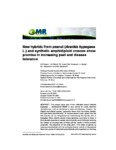Por favor, use este identificador para citar o enlazar este ítem:
http://www.alice.cnptia.embrapa.br/alice/handle/doc/1034692Registro completo de metadatos
| Campo DC | Valor | Lengua/Idioma |
|---|---|---|
| dc.contributor.author | FAVERO, A. P. | pt_BR |
| dc.contributor.author | PADUA, J. G. | pt_BR |
| dc.contributor.author | COSTA, T. da S. A. | pt_BR |
| dc.contributor.author | GIMENES, M. A. | pt_BR |
| dc.contributor.author | GODOY, I. J. | pt_BR |
| dc.contributor.author | MORETZSOHN, M. de C. | pt_BR |
| dc.contributor.author | MICHELOTTO, M. D. | pt_BR |
| dc.date.accessioned | 2016-01-21T11:11:11Z | pt_BR |
| dc.date.available | 2016-01-21T11:11:11Z | pt_BR |
| dc.date.created | 2016-01-21 | pt_BR |
| dc.date.issued | 2015 | pt_BR |
| dc.identifier.citation | Genetics and Molecular Research, v. 14, n. 3, p. 16694-16703, dec. 2015. | pt_BR |
| dc.identifier.uri | http://www.alice.cnptia.embrapa.br/alice/handle/doc/1034692 | pt_BR |
| dc.description | The primary gene pool of the cultivated peanut (Arachis hypogaea L., allotetraploid AABB) is very narrow for some important characteristics, such as resistance to pests and diseases. However, the Arachis wild diploid species, particularly those from the section Arachis, still have these characteristics. To improve peanut crops, genes from the wild species can be introgressed by backcrossing the hybrids with A. hypogaea. When diploid species whose genomes are similar to those of the cultivated peanut are crossed, sterile hybrids result. Artificially doubling the number of chromosomes of these hybrids results in fertile synthetic polyploids. The objectives of this study were: 1) to obtain progenies by crossing amphidiploids with the cultivated peanut, and 2) to characterize these two groups of materials (amphidiploids and progenies) so that they may be efficiently conserved and used. Using morphological, molecular, and pollen viability descriptors we evaluated one cultivar of A. hypogaea (IAC 503), eight synthetic amphidiploids, and the progenies resulting from four distinct combinations of crossing between IAC 503 and four amphidiploids. | eng |
| dc.language.iso | eng | pt_BR |
| dc.rights | openAccess | pt_BR |
| dc.subject | Interspecific hybrid | pt_BR |
| dc.subject | Characterization | pt_BR |
| dc.subject | Pollen viability | pt_BR |
| dc.subject | Groundnut | pt_BR |
| dc.title | New hybrids from peanut (Arachis hypogaea L.) and synthetic amphidiploid crosses show promise in increasing pest and disease tolerance. | pt_BR |
| dc.type | Artigo de periódico | pt_BR |
| dc.date.updated | 2016-03-01T11:11:11Z | pt_BR |
| dc.subject.nalthesaurus | germplasm | pt_BR |
| riaa.ainfo.id | 1034692 | pt_BR |
| riaa.ainfo.lastupdate | 2016-03-01 | pt_BR |
| dc.identifier.doi | 10.4238/2015.December.11.17 | eng |
| dc.contributor.institution | ALESSANDRA PEREIRA FAVERO, CPPSE | pt_BR |
| dc.contributor.institution | JULIANO GOMES PADUA, Cenargen | eng |
| dc.contributor.institution | TANIA DA SILVEIRA AGOSTINI COSTA, Cenargen | eng |
| dc.contributor.institution | MARCOS APARECIDO GIMENES, CENARGEN | eng |
| dc.contributor.institution | I. J. GODOY, Instituto Agronomico de Campinas | eng |
| dc.contributor.institution | MARCIO DE CARVALHO MORETZSOHN, CENARGEN | eng |
| dc.contributor.institution | M. D. MICHELOTTO, AGENCIA PAULISTA DE TECNOLOGIA PARA OS AGRONEGÓCIOS PINDORAMA. | eng |
| Aparece en las colecciones: | Artigo em periódico indexado (CPPSE)  | |
Ficheros en este ítem:
| Fichero | Descripción | Tamaño | Formato | |
|---|---|---|---|---|
| PROCI2015.00153.pdf | 557,04 kB | Adobe PDF |  Visualizar/Abrir |









